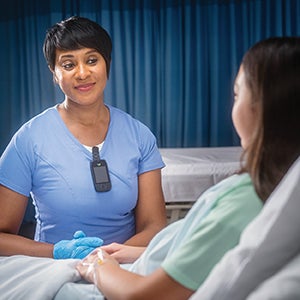Nurse communication systems keep advancing

Image courtesy of Watts
Nurse communication systems encompass a world of connectivity, as they interface with medical equipment, real-time locating systems (RTLSs) and Internet of Things-enabled devices.
The latest systems feature intuitive voice recognition and enable clinicians to update patients and families via texts, photos and videos. Despite these advances, however, manufacturers still face some challenges.
Hospitals are inundated with technology, and nurse communication systems are no exception, according to Bob Metzler, product director at Stanley Healthcare (becoming Securitas Healthcare), Portsmouth, N.H.
“The path to value in this segment comes from not only speeding up nurse communication but reducing the steps to employ such a system,” Metzler says. “As staffing shortages continue to impact care settings, the market is demanding more integration and fewer steps for the individual nurse to make use of each piece of technology.”
The right balance
A major challenge to making nurse communication systems work is finding the right balance between constant communication and alarm fatigue.
“Health care facilities often leverage multiple messages coming from disparate systems instead of one connected platform,” says Caryn Hewitt, R.N., CENO, CPHQ, senior director for consulting services at CenTrak, Newtown, Pa. “While this level of visibility is beneficial, targeted communications that go directly to the right caregiver can mitigate exposure to an excessive number of alarms and subsequent desensitization to important messages.”
Nurse communication systems are used with smartphones or other hand-held devices on a regular basis. Having the applications available on a mobile device allows nurses to see patient information at a glance and to allow for the clustering of care, which helps them be more efficient and spend more time with patients.
Nurse communication systems incorporate hand-held devices as an extension of their core functionality, not as an additional integration, according to Chris Miller, product architect at Amplion Clinical Communications Inc., Nashville, Tenn. “With this approach, technology providers can deliver improvements in care delivery more quickly and without extensive information technology work.”
Nurse communication systems must interface with other devices to maximize their effectiveness as they collect data directly from patient interactions, according to vendors. Without this connection, systems miss critical information about what is really happening when care is delivered to patients.
When nurse communication systems interface with a single solution, care providers get a more holistic depiction of patient care, according to Ted Ottenheimer, vice president for clinical data transformation at Ascom Americas, Morrisville, N.C. “Ascom’s Digistat platform does this through open integrations via multiple health care languages using drivers with medical devices, helping to address workflow issues that nurses encounter. Nurses can view near-real-time data acquired from medical devices and patient demographic information.”
Additional features
Other nurse communication systems available to the hospital market incorporate additional features.
For example, Stryker, Kalamazoo, Mich., has introduced the Vocera Minibadge, a wearable, voice-driven device that enables mobile workers to communicate hands-free. The Vocera Minibadge integrates with many clinical and operational systems and works in conjunction with Vocera smartphone apps, making it easy for hospital employees to use the mobile device that best suits their communication needs.
Like the Vocera Smartbadge, the Vocera Minibadge has intuitive voice recognition so that users can initiate a call with a simple voice command. It also features a dedicated panic button that sends an alarm to hospital security should a nurse be in distress.
Stryker also has introduced Vocera Ease, a HIPAA-compliant platform that enables clinicians to update patients and families via texts, photos and videos. “Vocera Ease also provides secure two-way video conferencing between patients, families and care teams,” says David Jones, senior clinical executive. “Messages, pictures and videos disappear 60 seconds after being viewed, and nothing is saved on the mobile device, providing security and privacy.”
CenTrak has introduced Workflow, a cloud-based clinical workflow solution that automates operations and nurse communications through each phase of clinical care. The software leverages CenTrak’s RTLS and location sensors. A staff display feature offers a view of patient and staff interactions, warning indicators for extended patient wait times, and time spent with each individual to help identify anomalies or bottlenecks.
Real-time patient information and clear staff communications keep operations in complex health care environments running smoothly.
“By using the software’s robust reporting engine, administrators and nurse managers can continuously measure interactions, such as patient volume, length of stay, room utilization, wait times, busiest windows, and time with providers to improve operations and monitor the impact of process changes,” Hewitt says. “Approved family members also gain automatic text messages with updates on patient status and care progression with no manual input from staff.”
Baxter Inc., Deerfield, Ill., has introduced the Hill-Rom Precision Locating RTLS, an ultra-wide band technology that provides submeter-level accuracy for staff duress and locating as well as asset tracking. “We’re excited about what this level of precision can do for care teams, as it integrates closely with our Voalte Nurse Call System,” says J.J. Holtfreter, marketing manager for nurse call and locating. “This combination of tools allows for workflow automation while providing battery-free room infrastructure that results in lower maintenance costs.”
Another feature from Baxter is a smartphone clinical communications app that streamlines secure messaging and collaboration between caregivers and patients.
West-Com Nurse Call Systems, Fairfield, Calif., offers the digital Patient CareBoard for inpatient rooms, which replaces dry erase or whiteboards. It integrates with nurse call systems and serves as a communication tool for patients, families and staff by displaying care and safety plans, all updated in real time. The company also has added the MobileCare app for Android and iOS platforms, which enables staff communication directly to patients.
“This solution shows all nurse call alerts, equipment alerts and call history on the caregiver’s mobile device, which saves time when assisting patients,” says Theresa O’Hollaren, chief nursing officer. “MobileCare also allows direct staff-to-staff calling and transfer of patient calls to other care team members.” West-Com also has introduced a rugged system specifically designed for behavioral health facilities.
The West-Com Connect system is capable of full integration with RTLS, O’Hollaren adds. When using the Patient CareBoard, the patient can see the picture, name and title of the caregiver entering the room. In addition, the RTLS can automatically cancel a call. This integration provides users with the ability to monitor additional metrics such as how much time nurses spend with each patient to further improve patient satisfaction.
Customized solutions
Jeron Electronic Systems Inc., Niles, Ill., has introduced the Provider 700 Nurse Call system, which supports patients, residents and staff with options that create customized solutions to meet the requirements of a wide range of health care facilities.
“This integrated system supports a facilitywide solution for wireless alerts and communications, real-time staff locating, one-touch workflows, real-time dashboard displays and activity reporting,” says Myles Cochran, Jeron’s director of marketing. “Because our systems are used worldwide, language on the nurse console can be programmed for Spanish.”
Adding the Jeron Noti-Fi smartphone alerting option to the Provider system gives caregivers both mobility and connection to their patients.
“No call goes unanswered when a patient places a call on the system, and text alerts instantly route to their caregiver’s smartphone,” Cochran adds. “Via Noti-Fi applications, the smartphone alerts staff to new resident or patient calls and displays key information at a glance, such as active calls with the room number, type of call priority and how long the call has been active, so there is no bottleneck accumulation.”
TekTone Healthcare Communications, Franklin, N.C., offers the Tek-Care Staff App, which enables the right caregiver to receive the right message — providing a quiet, alarm-free environment for patients and residents, according to Brad Hyder, marketing director. The app enables iPhone, iPad and iPod touch devices (plus any paired smartwatch) to display calls on the go, with selectable tone, vibrate or flash notifications. TekTone supports both iOS and Android devices.
“Our Tek-ALERT integration manager allows a facility to seamlessly integrate calls and activities from all systems and route those calls to the appropriate caregiver,” Hyder says. “By integrating hard-wired nurse calls, wireless nurse and emergency calls, fire alarms, security and access control systems, the integration manager provides health care facilities with a single point to manage staff and patient safety.”
Amplion Clinical Communications Inc. has focused on integrating its analytical platform, Care Analysis, with various middleware packages, including its Care Relate solution. “We’ve focused on compatibility with many other systems regardless of their age,” Miller says. “This approach keeps the focus on providing actionable information to the resources that need it most, at the lowest cost, and with the least amount of effort.”
Ascom Americas offers the Telligence nurse communication system with a Telliconnect feature that allows nurses to quickly access applications related to patient status and the care team. It also allows for configuration of a speed dial or manually dialed number so that nurses can call for translation service assistance or speak directly with a patient’s family.
“A Safe Connect feature with an easy-to-use plug reduces the number of broken pillow speaker connections and lets users add devices with a positive confirmation of data transmission through medical device integration, which is important for clinical decision support and alerting,” Ottenheimer says.
The core product for nurse communication at Stanley Healthcare (becoming Securitas Healthcare) is a location-enabling device with heavy integration capabilities that supports the larger enterprise, according to Metzler. “Our recent innovations have been geared toward reducing the size of the locating device, making the device easier to clean and improving the technology that is used to locate.”
The company also offers the Arial emergency and nurse call solution, which is for senior living and long-term care facilities. It features Arial Mobile, an all-in-one communication and alerting tool for caregivers. “With Arial Mobile, caregivers can not only receive alarms and critical alerts from all community systems, but also note who is responding, what task they are completing and how long it takes them,” says Mike Abcunas, director of product management.
“This information is critical for planning because it allows users to predict future events and allocate appropriately,” Abcunas adds. “The mobile application does not require cellular, which helps keep costs low. Instead, Arial Mobile uses the health care facility’s network to allow staff to text message, group message and conduct two-way voice calling, all from one device.”
Looking ahead
Holtfreter predicts vendors will continue to focus on improving data analytics, streamlining workflows and partnering with clinical leaders to drive stronger outcomes. “Communication systems are essential, but these systems need to provide necessary data to strengthen patient care, staff safety and workflow optimization, especially during this time of staff burnout and turnover,” he says.
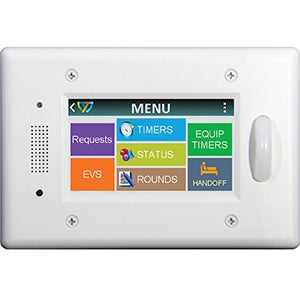
EASY COMMUNICATION
The Novus Workflow Station is a flexible, software-driven device designed to enhance clinical workflow by assisting staff-to-staff communications. West-Com Nurse Call Systems
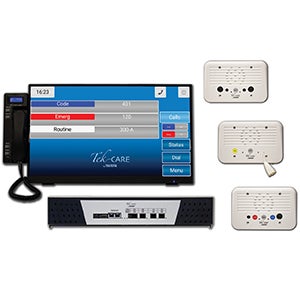
SPECIAL CONSIDERATIONS
The Tek-Care platform provides customizable communication solutions for all types of health care facilities. TekTone Healthcare Communications
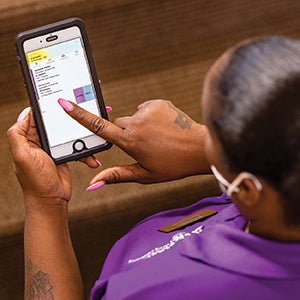
QUICK COMMUNICATION
The Arial Mobile application enables caregivers to quickly receive centralized alerts and communicate via voice or text directly in the app. Stanley Healthcare (becoming Securitas Healthcare)
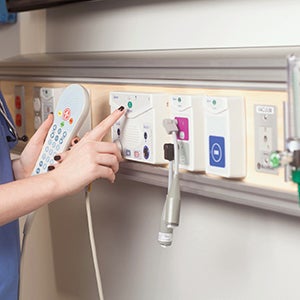
EFFICIENCY FIRST
The Provider nurse call system helps eliminate inefficiencies and boost direct patient care in health care facilities worldwide. Jeron Electronic Systems Inc.

SITUATIONAL AWARENESS
The Workflow system provides staff with real-time visibility to patient status and location for enhanced operations and efficient patient care. Centrak
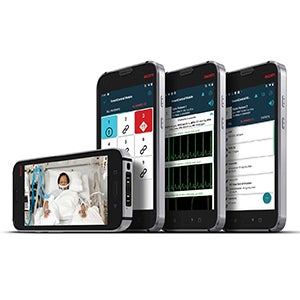
FAST ACTION
he Digistat platform provides early warning scoring via the Myco 3 smartphone. Ascom Americas

DATA DRIVEN
Care Analysis reduces nurse workload and improves scores by turning data from multiple systems into actionable information. Amplion Clinical Communications Inc.
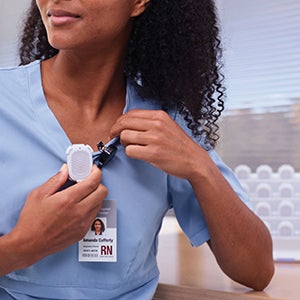
FINDER’S KEEPERS
Hill-Rom precision locating provides submeter-level accuracy for staff and asset tracking. Baxter Inc
Neal Lorenzi is a Mundelein, Ill.-based contributor to Health Facilities Management.


